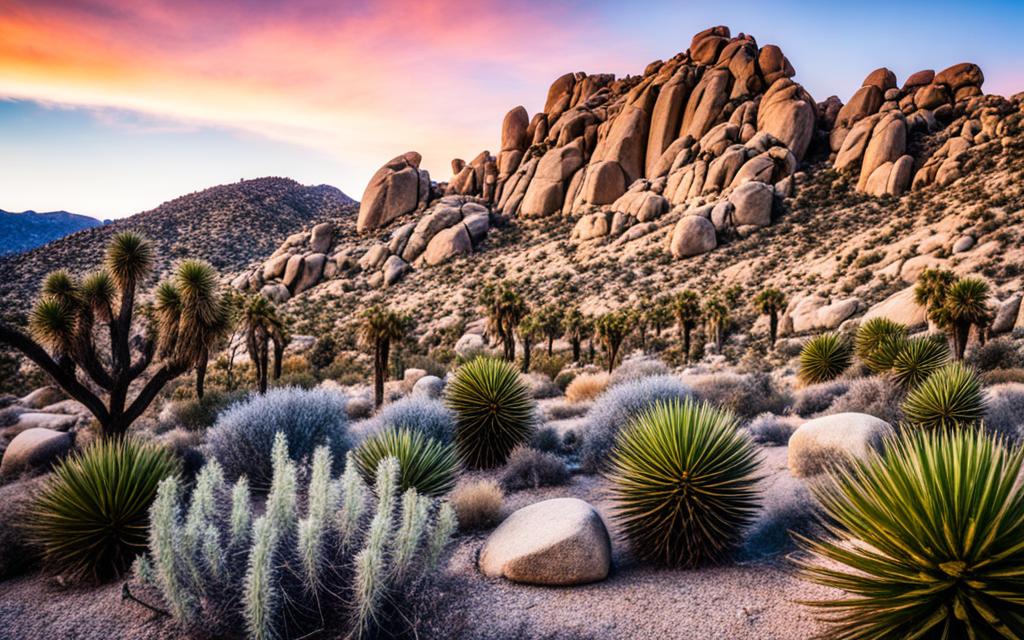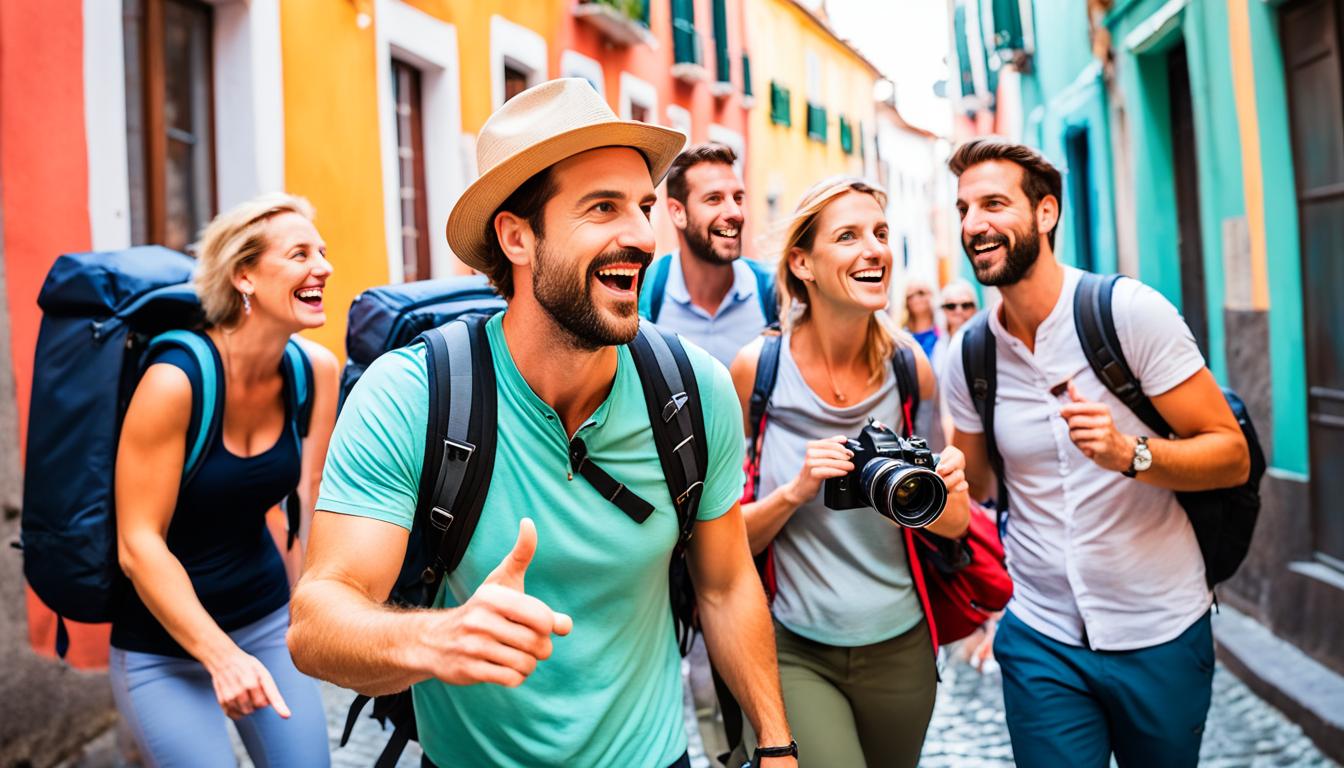Welcome to a world where the sun is king and the stars tell stories under the night sky. The Joshua Tree National Park climate is both captivating and tough. It has temperatures that you need to pay attention to. We’ll show you how to plan your trip to match Joshua Tree’s changing weather.
Temperatures here vary as much as the park’s unique landscapes. Every trip should be well-thought-out and adventurous. Spring brings wildflowers, while fall offers a soft golden light. The arid climate forecast guides and warns you. Visitors find peace in its vastness, with iconic Joshua trees standing tall.
Joshua Tree is a place of solitude that requires you to be self-sufficient. There are no stores or diners here. Being prepared means a safe and unforgettable adventure. Whether it’s a cold winter night or a hot summer day, Joshua Tree invites those who dare to explore.
This is your first step in exploring Joshua Tree’s unique desert climate. We’ll guide you through desert readiness. With the right information, you can enjoy the untouched beauty of this desert wonder.
Understanding Joshua Tree Weather for Your Trip
Before you head into Joshua Tree National Park, it’s important to know the weather. The Mojave Desert, where Joshua Tree is, has unique weather that changes a lot with the seasons.
Seasonal Temperature Patterns and What to Expect
Summer in Joshua Tree can get very hot, often over 100°F. This makes hiking during the day risky. On the other hand, winter nights can get cold, sometimes freezing. Rare snowfall adds beauty to the desert, attracting those who love this unique sight.
Journey Planning: Best Times to Visit Joshua Tree National Park
The best time to visit is from October to May, when it’s cooler. This is perfect for exploring and seeing the park’s plants and animals. February to April is especially good, with wildflowers blooming if it rains in winter. To avoid crowds, try visiting on weekdays or go for sunrise hikes.
Tips for Managing Desert Heat Conditions and Cold Nights
Planning is key for the desert’s extreme weather. Night hiking is a good idea in the summer to avoid the heat and see the stars. Always carry enough water and wear light clothes to stay cool. For cold nights, bring a good sleeping bag to stay warm.

Knowing about the weather in Joshua Tree and preparing for it is crucial for a safe and fun trip. Whether you’re hiking, stargazing, or seeing desert flowers, understanding the climate will help make your visit unforgettable.
Joshua Tree National Park Climate: Preparing for a California Desert Experience
The Joshua Tree National Park climate changes a lot with the seasons. It shows how dry and hot the area is. It’s important to know this to get ready for the heat and cold.

In the summer, the heat can go over 100°F. This is very hot. But in the winter, it’s cooler, in the mid-50s to low 60s°F. At night, it can get really cold, near freezing.
This big change in temperature makes the park a special place. It’s hard to visit because of the heat and cold.
| Season | Daytime Temperatures | Nighttime Temperatures | Visitor Tips |
|---|---|---|---|
| Winter | 50s to low 60s°F | 30s to 40s°F | Layer clothing, plan for chilly nights |
| Spring | Mid-60s to mid-80s°F | Mid-40s°F | Perfect for hiking, witness wildflower blooms |
| Summer | Over 100°F | 70s°F (night) | Visit early morning or late evening, carry water |
| Fall | 75°F to 85°F | Approximately 50°F | Great for stargazing and attending local festivals |
The park is one of California’s three Dark Sky parks. This is great in the fall when it’s cooler. Spring is busy because of the wildflowers and the Joshua Tree Music Festival. Summer is quiet because of the heat.
Park rangers say to bring at least one gallon of water per person per day. This helps with the heat. Knowing about the dry weather and getting good advice makes visiting the park better and safer.
Activities and Safety Considerations in Various Weather Conditions
Exploring Joshua Tree National Park means being ready for extreme weather, from hot desert heat to cold winters. It’s important to know how the weather affects your plans, whether you’re hiking, climbing, or just taking in the views.
Staying Safe in Arid Heat Extremes and Chilly Winters
Being prepared is crucial in the desert. In summer, it gets very hot, so drinking lots of water is key to staying hydrated. For winter, dress in layers and use wind-proof gear to avoid getting too cold.
Outdoor Pursuits: Capitalizing on Mojave Desert Temperature Swings
Planning is important for day hikes and overnight trips in Joshua Tree. Try to hike early in the morning or late afternoon to avoid the hottest part of the day. The park has trails for all levels, from easy walks to tough climbs. Always be ready for the weather to change suddenly, which can be dangerous.
| Activity Level | Distance (Miles) | Elevation Gain/Loss (Feet) | Recommended Gear |
|---|---|---|---|
| Easy | Up to 2 | Up to 100 | Standard hiking gear, 1 gallon of water |
| Moderate | Up to 5 | Up to 500 | Hydration packs, snacks, sun protection |
| Challenging | Up to 8 | Varied | Advanced navigation tools, extra water |
| Strenuous | Up to 10 | Up to 2000 | High-calorie foods, layered clothing |
| Extreme | 12+ per day | Varied, often steep | Emergency kit, multi-day supplies |
Essential Gear for Weathering the High Desert Climate
Visiting Joshua Tree National Park takes you into a vast, arid landscape of nearly 800,000 acres. You might want to see stunning sunrises, climb the rugged mountains, or explore trails like Hidden Valley or Ryan Mountain. It’s key to know and prepare for the desert climate. You’ll need special gear to stay safe and enjoy your adventure.
Packing for Arid Climate Forecast: Must-Have Items
Getting the right gear is crucial in the unpredictable desert. Make sure to pack UV-protective clothes, sturdy shoes, first aid kits, navigation tools, and versatile camping gear. These items help you handle the desert’s heat and cold. Even in mild seasons, the desert can quickly change, so be ready for anything.
Adapting to Dry Heat Extremes with Smart Hydration Solutions
Hydration is key in the desert. Carry at least one gallon of water per person each day to avoid dehydration. But it’s not just about drinking water. Think about portable shade, efficient tents, and battery-powered lamps for your needs. These items help you stay safe and comfortable in the desert’s harsh conditions.
Source Links
- https://www.hipcamp.com/journal/camping/whats-the-best-time-of-year-to-camp-at-joshua-tree/
- https://www.stayfieldtrip.com/blog/best-time-to-visit-joshua-tree/
- https://roads.porsche.com/en/national-parks-california/joshua-tree
- https://hikingguy.com/hiking-trails/joshua-tree-hikes/joshua-tree-hiking-tips/
- https://www.nationalgeographic.com/travel/national-parks/article/joshua-tree-national-park
- https://www.shakaguide.com/article/joshua-tree/best-time-to-visit-joshua-tree
- https://www.destinationdaydreamer.com/things-you-need-to-know-joshua-tree-national-park/
- https://www.nps.gov/jotr/planyourvisit/safety.htm
- https://joshuatree.org/know-before-you-go/
- https://www.outwardboundcalifornia.org/planning/environmental-hazards-plan/
- https://storyateverycorner.com/joshua-tree-national-park-day-trip-from-palm-springs/
- https://rainbowtravellife.com/the-ultimate-two-day-itinerary-to-visit-joshua-tree-national-park/

